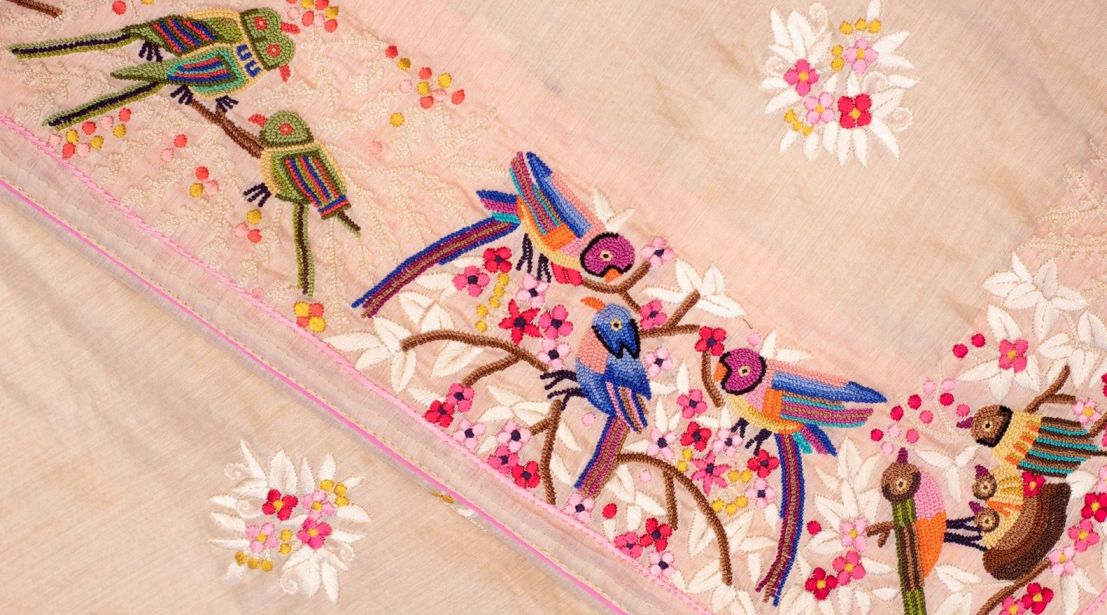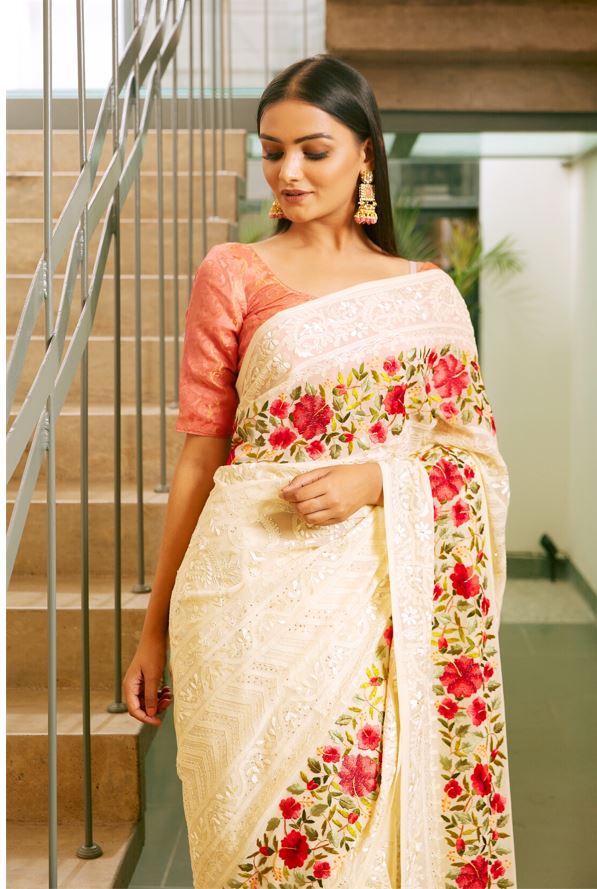Picking up the colourful silken thread with a tiny needle and deftly pricking the finest hand woven Pashmina shawl stretched across the embroidery, wooden frame to make an intrinsic motif, is what Pia Chatterjee, Rupsana Khatoon, Rita Mondol, Mou Jana, Falguni Maity, Mita Mondol, and 100 other women, are doing. They are happily chatting but completely focused on embroidering a canvass of art.
Yes, their work in Petit point and Gara embroidery motifs on sarees, shawls or dupattas are no less than a work of art. Their work is sure to receive compliments, if exhibited along with the works of legendary artists like Raja Ravi Varma, Vincent Van Gogh, Michelangelo or any other great artists of the world.
The women from humble backgrounds—few from tribal land, few others from places with limited opportunities—haven’t finished their high school education. The only language they speak is a dialect of Bengali as they all reside in the underdeveloped hamlets around Midnapore, Hooghly, Bankura of West Bengal. But they all love watching Hindi films, especially films of Salman Khan, Akshay Kumar without understanding Hindi.
“This is my eighth year. I trained here for six months and now love making different flowers, leaves, birds with a needle and colourful resham (silk) thread,” says 26-year-old Pia.
“I have been working here for 12 years now and we have all become a family. We work, eat, share our problems, talk about films and enjoy our time here along with the work,” adds 34-year-old Rupsana.
Mother of two daughters, the 42-year-old Mita explains that she loves to see photographs of rich women in far off places dressed in their creations. For 15 years she has been working in this place and says, “We feel proud when we see women dressed in our work. The embroidery is so intricate and beautiful that when people appreciate our work, we are happy.”
They are all part of Prastuti Designs, an over-30-year-old design organisation. None of the products produced on completely handwoven silks, wool fabric are sold for anything less Rs 15,000 per piece and the highest price can go into lakhs.
“My mother, Deepa Gupta, had started working with around 600 women in Kantha embroidery style. But my sister Tanvi and I, wanted to do something different and so started the Gara and Petit point in our units,” explains 45-year-old Anshul Gupta, the man behind the revised Prastuti Designs, which so far has worked with more than 1,200 women over the last two decades.
But how did Gara and Petit point, which are non-Indian embroidery styles, get established in this region?
Design Inspirations From Abroad

Gara is known as the Parsi sari worn during special occasions like weddings or festivals. Gara sari to a Parsi bride is like the Benarasi brocade sari to a North Indian bride, a Kanchipuram sari to a South Indian bride or a Paithani sari to a bride from Maharashtra. Gara embroidery was introduced in India by a Parsi businessman travelling to China on trade. One of them brought a fabric that had this embroidery which depicted the flora and fauna so beautifully that it almost appeared as though the flowers were real and the new Parsi women settlers who wanted to have an identity in India decided to adopt it as part of their wedding trousseau.
Petit point embroidery, famous as the embroidery of France, was popular in the 17th and early 18th century. It was brought to India by European settlers and missionaries. The stitches are so small that nearly 1,000 stitches are stitched in one square inch area. Each stitch can be made with different coloured thread, making the piece unbelievably attractive. The problem with both Gara and Petit point is that they are very difficult to master and very time consuming to make.
It takes nearly 1,500 to 5,000 hours to make a sari and the reason why 10 to 12 women are assigned to work together on a sari so that it can be completed on time. No machine can replicate this embroidery and this increases the cost of the end product.
Retrieving Lost Embroidery

At any given point there are more than 350 women working in three units of Prastuti spread in three different areas in the hinterland of West Bengal. Added to this are more than 300 people indirectly involved by undertaking other jobs for Prastuti.
Deepa Gupta started Prastuti with only women who make beautiful products from Kantha style embroidery in the 1990s. It became famous for authentic Kantha products. So, Anshul and Tanvi were exposed to Kantha styles from the beginning.
Around the turn of this century, Anshul was pursuing his chartered accountant degree (CA) but one mark less to succeed in the final exams changed his future. In fact, growing up in the atmosphere of fabric, threads, designs and embroidery he was never too fond of pursuing a career as a CA.
“That was also the time when suddenly in the world of embroidery, people started talking about Gara and Petit point. Like all other handmade items even these two styles had almost vanished. In Mumbai I met one Ms Aagha and knowing my interest in embroidery, she suggested introducing these styles in our units,” recalls Anshul.
To introduce these two styles which were completely alien in his land was daunting. Luckily, he met two embroiderers Mukhtarbhai and Gulambhai—both expert embroiderers of these styles—wanting to return to their homes in Bengal from Uttar Pradesh where they had trained and worked as master embroiderers. They agreed to train the women in these styles.
Of course there was a lot of opposition to learn something new that required hard work, as these women knew Kantha from their childhood and were worried about employment opportunities. But they were promised sure employment in good working conditions.
Today, every trainee is paid a monthly stipend of Rs 500 for six months. After training, the successful trainees are absorbed in the unit at a wage of Rs 300 a day of eight hours, for 360 days in a year.
Though anyone can take leave at any time, the units function throughout the year except during the Durga Puja — a big festival in West Bengal. Plus Rs 3,000 interest free loan is given to buy bicycles for women to travel from their homes to the units. Majority of these women cycle to their workplace as it saves them time and money from using erratic public transport. So, depending on the days they put in, they earn anywhere between Rs 2,500 to Rs 7,500 per month. It also provides them with safety from child marriages and harassment at home.
Their earning gives them strength.
Falguni Maity, 32, who has been with Prastuti for 12 years now says, “I love to cycle to my workplace. Even during the monsoon, I either wait till it stops raining or carry change of clothes which I change in our unit’s restroom after I reach here. Cycling saves me the hassle of waiting for public transport.”
That’s another reason why women love to work at Prastuti. Unlike many other such units in the country, Prastuti maintains clean and good restrooms for their workers. Added to this are the air-conditioners installed in two units, which make it comfortable to work in summer.
“We also serve free lunches of rice and egg curry or rice and fish curry with some torkari (vegetables),” explains 51-year-old Biplab Mazumdar, who has been working as a supervisor in one of the units for more than two decades. Even his mother and four sisters worked as embroiderers here.
With high net worth clients, who can afford these heirloom products, Anshul Gupta wants to branch out slowly to begin other styles of hand embroidery prevalent across the country.
He hopes this will generate more employment for the women of the hinterland of West Bengal, and that many of the vanishing hand embroidery styles will get a new lease of life.
(Edited by Yoshita Rao)
No comments:
Post a Comment